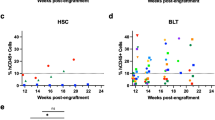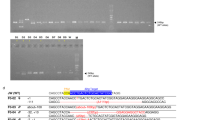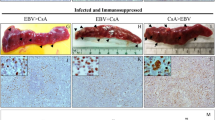Abstract
DURING normal fetal ontogeny, one of the first organs to harbour CD4-positive cells is the thymus1. This organ could therefore be one of the earliest targets infected by human immunodeficiency virus type 1 (HIV-1) in utero. HIV-1-infected cells and pathological abnormalities of the thymus have been seen in HIV-1-infected adults and children, and in some fetuses aborted from infected women2–5. Studies of HIV-1 pathogenesis have been hampered by lack of a suitable animal model system. Here we use the SCID-hu mouse6 as a model to investigate the effect of virus infection on human tissue. The mouse is homozygous for the severe combined immunodeficiency (SCID) defect7,8. The model is constructed by implanting human fetal liver and thymus under the mouse kidney capsule. A conjoint human organ develops, which allows normal maturation of human thymocytes. After direct inoculation of HIV-1 into these implants, we observed severe depletion of human CD4-bearing cells within a few weeks of infection. This correlated with increasing virus load in the implants. Thus the SCID-hu mouse may be a useful in vivo system for the study of HIV-1-induced pathology.
This is a preview of subscription content, access via your institution
Access options
Subscribe to this journal
Receive 51 print issues and online access
$199.00 per year
only $3.90 per issue
Buy this article
- Purchase on Springer Link
- Instant access to full article PDF
Prices may be subject to local taxes which are calculated during checkout
Similar content being viewed by others
References
McCune, J. M. Cell 64, 351–363 (1991).
Grody, W., Fligiel, S. & Naeim, F. Am. J. Clin. Path. 84, 85–95 (1985).
Joshi, V. V. et al. Arch. Pathol. Lab. Med. 110, 837–842 (1986).
Mano, H. & Chermann, J. C. AIDS Res. Human Retroviruses 7, 83–88 (1991).
Papiernik, M. et al. Pediatrics 89, 297–301 (1992).
McCune, J. M. et al. Science 241, 1632–1639 (1988).
Bosma, G. C., Custer, R. P. & Bosma, M. J. Nature 301, 527–530 (1983).
Schuler, W. et al. Cell 46, 963–972 (1986).
Namikawa, R., Kaneshima, H., Lieberman, M., Weissman, I. L. & McCune, J. M. Science 242, 1684–1686 (1988).
Koyanagi, Y. et al. Science 236, 819–822 (1987).
Mocarski, E. S., Bonyhadi, M. L., Salimi, S., McCune, J. M., & Kaneshima, H. Proc. natn. Acad. Sci. U.S.A. 90, 104–108 (1993).
Adachi, A. et al. J. Virol. 59, 284–291 (1986).
Bonyhadi, M. L. et al. Nature 363, 728–732 (1993).
Hays, E. F., Uittenbogaart, C. H., Vollger, L. W., Brewer, J. & Zack, J. A. AIDS 6, 265–272 (1992).
Namikawa, R., Weilbaecher, K. N., Kaneshima, H., Yee, E. H. & McCune, J. M. J. exp. Med. 172, 1055–1063 (1990).
Kaneshima, H. et al. Proc. natn. Acad. Sci. U.S.A. 88, 4523–4527 (1991).
Cann, A. J., Koyanagi, Y. & Chen, I. S. Y. Oncogene 3, 123–128 (1988).
Zack, J. A. et al. Cell 61, 213–222 (1990).
Zack, J. A., Haislip, A. M., Krogstad, P. & Chen, I. S. Y. J. Virol. 66, 1717–1725 (1992).
Author information
Authors and Affiliations
Rights and permissions
About this article
Cite this article
Aldrovandi, G., Feuer, G., Gao, L. et al. The SCID-hu mouse as a model for HIV-1 infection. Nature 363, 732–736 (1993). https://doi.org/10.1038/363732a0
Received:
Accepted:
Issue Date:
DOI: https://doi.org/10.1038/363732a0
This article is cited by
-
Benefits and limitations of humanized mice in HIV persistence studies
Retrovirology (2020)
-
Engineering approaches for regeneration of T lymphopoiesis
Biomaterials Research (2016)
-
TALEN gene editing takes aim on HIV
Human Genetics (2016)
-
Animal models for HIV/AIDS research
Nature Reviews Microbiology (2012)
-
The utility of the new generation of humanized mice to study HIV-1 infection: transmission, prevention, pathogenesis, and treatment
Retrovirology (2011)
Comments
By submitting a comment you agree to abide by our Terms and Community Guidelines. If you find something abusive or that does not comply with our terms or guidelines please flag it as inappropriate.



